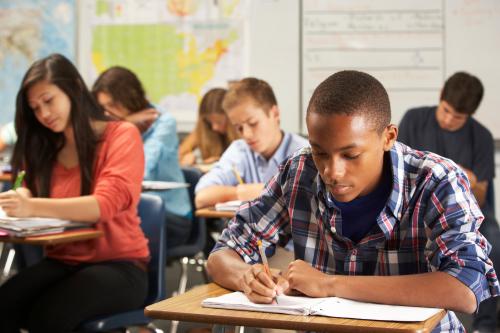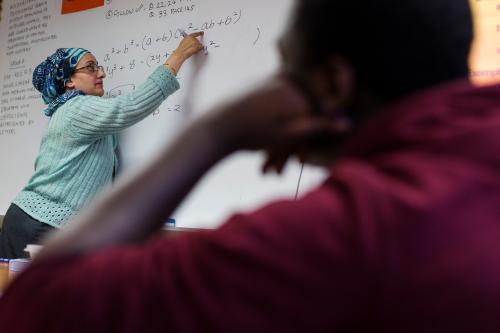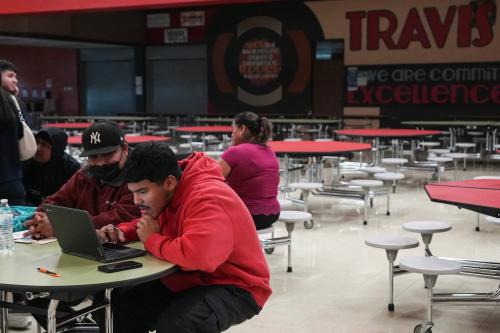In 2014, the U.S. Departments of Education and Justice jointly released guidance to public schools on how to avoid racial discrimination in the administration of school discipline. The Obama-era school discipline guidelines were motivated in part by large and persistent racial disparities in suspensions (see Figure 1), as well as a vast body of research linking exclusionary school discipline to deleterious downstream effects.
The 2014 guidelines stressed that racial disparities in discipline rates, in and of themselves, could constitute evidence of unlawful discrimination. The 2014 guidance was rescinded by the Trump administration in 2018, though the Biden administration has signaled that revised guidance on avoiding racially discriminatory school discipline may be forthcoming. If future guidelines are anything like the Obama-era guidance, administrators and educators might soon be asking themselves how they can work to reduce racial discipline disparities.
What does research suggest is the best approach?
Unfortunately, the answer to that question isn’t straightforward. Some interventions have shown promise in reducing the use of exclusionary discipline practices overall. However, few have succeeded in reducing large racial disparities in discipline. (For a more comprehensive discussion on this point, see recent research reviews by Welsh and Little and Cruz, Firestone, and Rodl.)
Here, I draw on two decades of school discipline research to summarize what we’ve learned about how to reduce racial discipline disparities. It is important to note that school discipline reforms often aim to meet multiple goals (e.g., reducing the use of exclusionary discipline overall, reducing racially disparate outcomes, and improving school climate), and can have intended and unintended consequences for a school community. For clarity and brevity, I focus this discussion specifically on whether interventions reduce racial disparities in school discipline outcomes by lowering discipline rates for students of color.
Popular school discipline reforms, as implemented, generally have not closed racial gaps.
Positive Behavioral Interventions and Supports (PBIS) is a popular school-wide program that aims to reduce the use of exclusionary discipline and improve school climate by instituting school-wide behavioral norms and supports. For example, PBIS schools typically adopt school-wide behavioral expectations and a system of rewards for students exhibiting positive behaviors. Research shows that the adoption of PBIS in a school typically leads to an overall reduction in disciplinary incidents and suspensions. However, other work indicates that PBIS alone does not reduce racial disparities in discipline.
Restorative justice is another prevalent approach. Restorative Justice (RJ) programs aim to create inclusive and equitable learning environments by engaging students in conflict resolution as an alternative to traditional exclusionary discipline practices. To date, research suggests that RJ programs have not led to substantial reductions in racial disparities and, in some cases, have exacerbated racial inequalities. These studies have evaluated RJ programs in Pittsburgh, Denver, Los Angeles, and other large urban districts in the U.S. As researchers have argued, these results are not necessarily an indictment of RJ programs and its underlying philosophy, as RJ programs show promise for reducing racial disparities when implemented well. However, these findings underscore the significant implementation challenges schools and districts have faced in adopting RJ programs. For example, the RJ programs rolled out in Pittsburgh public schools were not implemented as an alternative to punitive disciplinary practices but rather as an appendage to existing disciplinary practices and policies.
Policymakers in many localities have also attempted to address long-standing racial disparities in discipline through changes to state- and district- level policy. For example, California banned the use of suspensions for “willful defiance,” a category of low-level misconduct that relies on educators’ subjective interpretation of students’ behavior. These policies are motivated by prior research highlighting that racial disparities are prevalent for these types of relatively minor offenses. Research on the efficacy of state-level policy changes is scant. The limited research evaluating district-level policies suggests that Los Angeles’s suspension ban was associated with a modest reduction in racial disparities. Work from Philadelphia shows no impacts of a district-level change to its suspension policies on racial gaps, which the authors argue may be driven by lower levels of compliance with revised suspension policies in schools serving students of color.
Two other school-level interventions that have not shown promise in eliminating disparities are worth highlighting. First, research indicates that sharing monthly data on disciplinary equity to school administrators does not reduce racial disparities in disciplinary referrals. Second, research shows that the presence of school resource officers (SROs or sworn law enforcement officers assigned to schools) significantly widens racial disparities in suspensions. This effect is driven by increases in schools’ reliance on exclusionary discipline following the placement of SROs in schools. (Importantly, this work also shows that SROs reduce some forms of violence in schools, although not gun-related incidents.)
So, what has worked?
While the research base is limited, the interventions and policy efforts that have shown the most promise have two things in common. First, they take seriously the roles that discrimination and bias, and other racial dynamics, play in shaping many aspects of schooling—including, but not limited to, school discipline practices and policies. As many scholars have argued, race and racism are central to understanding how racial disparities develop and persist, and interventions that do not address these factors are unlikely to reduce disparities. In fact, research suggests that adopting a racially and culturally conscious approach towards implementation can turn an ineffective program into an effective one. For example, when PBIS was implemented alongside a racial equity focused professional development program for administrators and teachers in a rural district in the southeast, participating schools saw significant reductions in racial disparities.
The second commonality across the promising interventions and policy efforts is that they aim to improve relationships between teachers and students. In an important theoretical article, social psychologist Jason Okonofua and colleagues argue that students of color and teachers can fall into a “vicious cycle” of mistrust driven by harmful and racist stereotypes and the effects those stereotypes have on teachers, students, and teacher-student relationships. This mistrust contributes to racial discipline disparities. The authors argue that interventions aimed at improving the quality of teacher-student relationships—either by intervening with teachers, or students, or both simultaneously—can interrupt this negative cycle and have long-lasting positive effects for students of color.
On the teacher side, Okonofua and colleagues tested an empathic-mindset intervention for teachers, which works to “sideline” the role racial bias plays in school discipline by encouraging teachers to take a more empathetic and relational approach towards engaging with their students (even when they misbehave). This study found large and sustained reductions of racial disparities in suspension rates among students whose teachers participated in the intervention.
On the (middle school) student side, the evidence on social-psychological interventions that aim to disrupt the “vicious cycle” is mixed. These interventions typically look to bolster students’ self-confidence and sense of belonging to insulate racially minoritized students from the harms of stereotype threat. For example, one intervention produced significant reductions in disciplinary incidents for racially minoritized boys. On the other hand, a series of studies have tested the impact of self-affirmation interventions (which similarly aim to limit the harmful impact of negative stereotypes on students’ development) on school discipline disparities to mixed results. Other research offers one explanation for these mixed findings, suggesting that these types of interventions may only be effective in majority-white school settings where students of color are in the minority (where stereotype threat is hypothesized to be the most salient).
A few other programs and policies show promise in reducing discipline disparities. For example, teachers that participated in the My Teaching Partner coaching program—which aims to improve student-teacher relationships and increase student engagement—referred students for discipline at racially equal rates.
Finally, and maybe most importantly, a large body of research underscores the need to diversify the teaching workforce. Studies in both North Carolina and New York City show that students of color exposed to same-race teachers have lower rates of discipline. Interestingly, a separate North Carolina study finds that both white and Black teachers trained at historically black colleges and universities (HBCUs) are less likely to suspend Black boys relative to their non-HBCU trained colleagues. Diversifying the teaching workforce in terms of both teachers’ racial/ethnic backgrounds and their training may have positive implications for racial equity in discipline.
Where do we go from here?
One of the most important lessons from the last decade-plus of various efforts to reform school discipline and improve racial equity is the need for racially and culturally conscious implementation. This means that researchers, policymakers, administrators, and educators need to attend to the myriad ways that race, class, gender, power, and privilege shape school processes including the administration of discipline. As Anne Gregory and Russell Skiba (leaders in the field of school discipline) have argued, we shouldn’t rely on race-neutral strategies and then “implement and hope” they’ll reduce racial disparities. They probably won’t.
As for specific programs, despite the bumpy rollout, restorative justice programs show promise when they are implemented with fidelity and supplant existing discipline structures and practices. Moreover, some social-psychological interventions with students and teachers have shown potential to disrupt the “vicious cycle” of mistrust between students of colors and their teachers. Still, it is important to note that most interventions have been evaluated in only a few school districts (if that). As such, we’re still learning about when, where, and how they work.
Finally, the need to reform school discipline and narrow racial gaps further bolsters the case for diversifying the teaching workforce.
If the Biden administration releases new guidance on racial discrimination and school discipline, let’s not repeat the “implement and hope” approach that has characterized the last decade or so of school discipline reform efforts. Instead, researchers (like myself), policymakers, and practitioners should work together to build on what we’ve learned about racial discipline disparities and various reform efforts to finally eliminate racially disparate discipline outcomes.
-
Acknowledgements and disclosures
The author thanks Logan Booker for excellent research assistance on this blog.








Commentary
Reforming school discipline: What works to reduce racial inequalities?
September 12, 2022